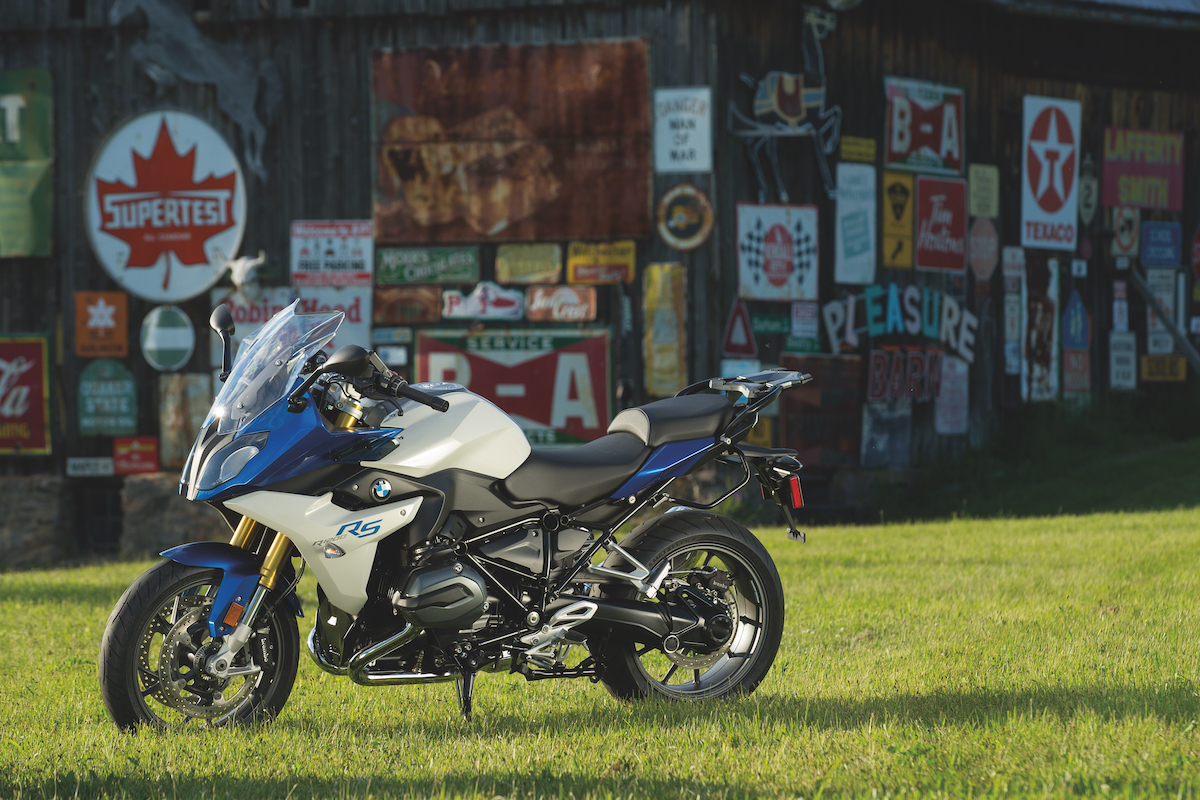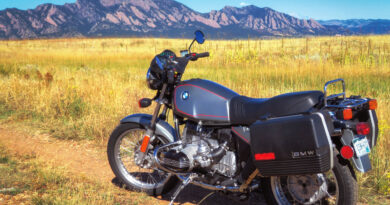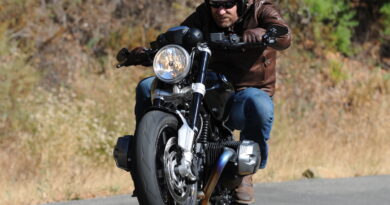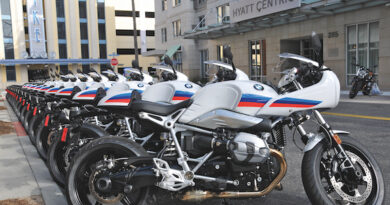R 1200 RS: Bridging the gap between Touring and Sport
Photos by Kevin Wing
In 1976, BMW introduced the R 100 RS. The motorcycle was built as an all-rounder, equally adept at spirited sport riding as it was at comfortably traveling across the country, and it was also the first mass-produced motorcycle equipped with a full, frame-mounted fairing developed in a wind tunnel. With the R 100 RS, BMW had created a new classification: Sport Touring.
The 2015 R 1200 RS is the first RS to be released in nearly a decade and represents the sportiest touring bike BMW has ever produced to carry on the model’s broad range of appeal. While the BMW website labels the K 1600 GT/GTL and the R 1200 RT as Tour models, the R 1200 RS rides along with the K 1300 S and S 1000 RR in the Sport group.
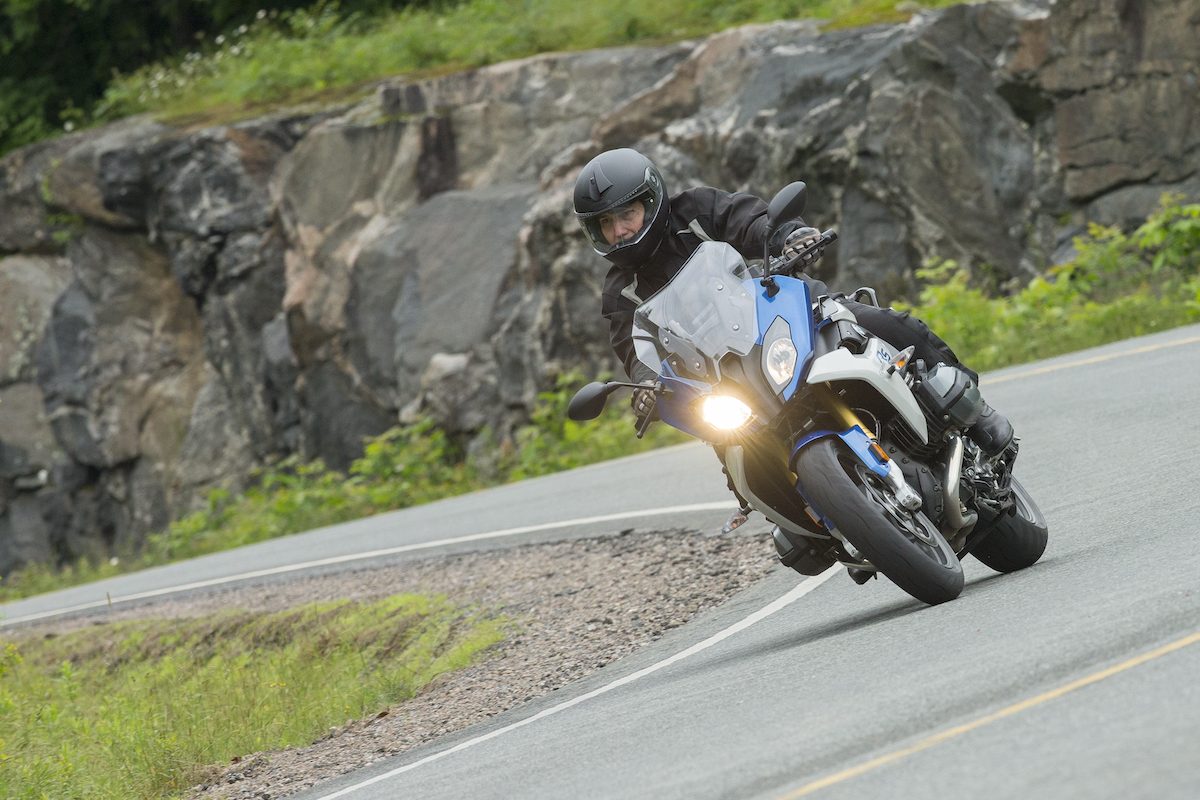 The new RS is powered by the same DOHC 1,170 cc boxer engine used in the naked R 1200 R, the R 1200 GS, the R 1200 GS Adventure and the R 1200 RT, and produces 125 hp at 7,750 rpm with a peak torque number of 92 ft-lbs at 6,500 rpm. Riders familiar with boxers will immediately feel at home with the tractor-like power delivery and broad power band with more than 74 ft-lbs of torque always available across the usable rev range. With the RS’s modified airbox and new exhaust, the low-end torque is even better than that on the new R 1200 GS, GS Adventure and RT. Like those models, a six-speed gearbox transfers power to the rear wheel via shaft drive.
The new RS is powered by the same DOHC 1,170 cc boxer engine used in the naked R 1200 R, the R 1200 GS, the R 1200 GS Adventure and the R 1200 RT, and produces 125 hp at 7,750 rpm with a peak torque number of 92 ft-lbs at 6,500 rpm. Riders familiar with boxers will immediately feel at home with the tractor-like power delivery and broad power band with more than 74 ft-lbs of torque always available across the usable rev range. With the RS’s modified airbox and new exhaust, the low-end torque is even better than that on the new R 1200 GS, GS Adventure and RT. Like those models, a six-speed gearbox transfers power to the rear wheel via shaft drive.
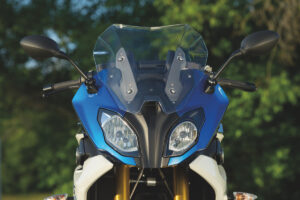 While nearly identical to the R 1200 R, the new RS arrives with an angular fairing design and symmetrical dual headlights that share a family resemblance to the fairings of the S 1000 RR and S 1000 XR. The fairing is the primary reason for the bike weighing in at 520 pounds, 12 more than the R 1200 R.
While nearly identical to the R 1200 R, the new RS arrives with an angular fairing design and symmetrical dual headlights that share a family resemblance to the fairings of the S 1000 RR and S 1000 XR. The fairing is the primary reason for the bike weighing in at 520 pounds, 12 more than the R 1200 R.
In its standard configuration, the new RS is delivered in an attractive Lupin blue/Light grey metallic finish with black frame, wheels, motor and Paralever. The Style 2 Package offers a sexy Granite grey matte/Blackstorm metallic matte finish set off with gold brake calipers front and rear, an engine spoiler and a stainless steel center tank cover. With either configuration, upside down telescopic forks are gold when the bike is equipped with Dynamic ESA and silver when it isn’t. In addition to the standard seat (32.3”), low and high options are available. Fairing mounted mirrors and an adjustable windscreen complete the look.
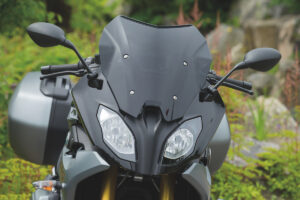 Additional standard features include Automatic Stability Control (ASC), a centrally positioned radiator offering a compact front end, radial brake calipers, ABS and two riding modes: Rain and Road.
Additional standard features include Automatic Stability Control (ASC), a centrally positioned radiator offering a compact front end, radial brake calipers, ABS and two riding modes: Rain and Road.
Options include Ride Modes Pro, which adds Dynamic and User modes, plus Dynamic Traction Control (DTC), Dynamic Electronic Suspension Adjustment (D-ESA), Shift Assist Pro for clutchless up and down shifting, and a Keyless Ride option. On Board Computer Pro allows riders to customize how information is displayed on the instrument cluster in Full, Sports and Tour modes and allows data transfer with the new BMW Navigator V.
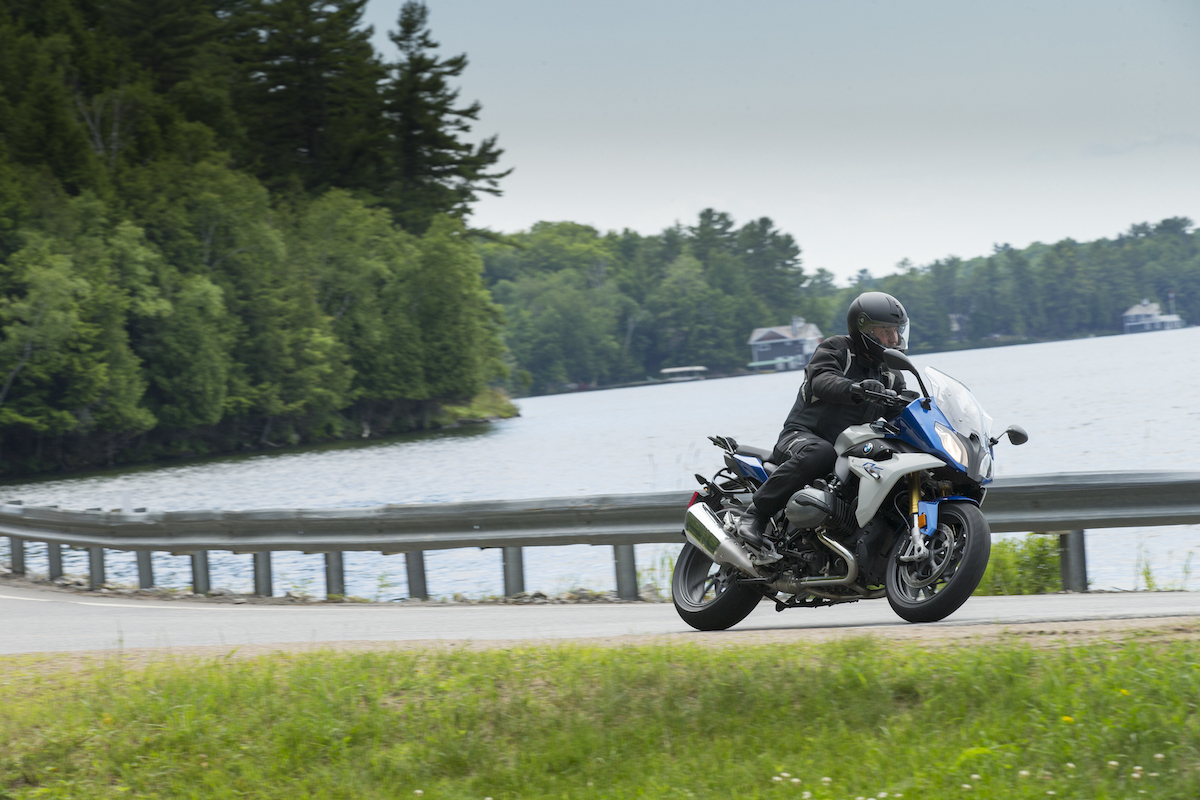 Though the base price for the R 1200 RS is $14,950 in Lupin Blue Metallic/Light Grey Metallic and $15,375 for the Style 2 option, base models aren’t typically ordered by dealers. Instead, bikes adding the Standard configuration including GPS preparation, a chrome exhaust, heated grips, cruise control and saddle bag mounts will list at $16,025 or at $17,895 when the Premium Package options including Keyless Ride, Gear Shift Assist Pro, Tire Pressure Monitor, Dynamic ESA, On Board Computer Pro, luggage rack, and center stand are added.
Though the base price for the R 1200 RS is $14,950 in Lupin Blue Metallic/Light Grey Metallic and $15,375 for the Style 2 option, base models aren’t typically ordered by dealers. Instead, bikes adding the Standard configuration including GPS preparation, a chrome exhaust, heated grips, cruise control and saddle bag mounts will list at $16,025 or at $17,895 when the Premium Package options including Keyless Ride, Gear Shift Assist Pro, Tire Pressure Monitor, Dynamic ESA, On Board Computer Pro, luggage rack, and center stand are added.
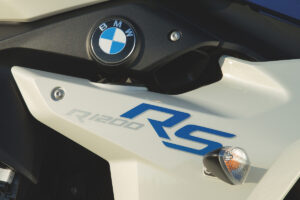 Other available options include BMW Navigator V, anti-theft alarm, crash bars, tank bag, side cases, LED auxiliary lights and top case. Just like at Burger King, you can have it your way.
Other available options include BMW Navigator V, anti-theft alarm, crash bars, tank bag, side cases, LED auxiliary lights and top case. Just like at Burger King, you can have it your way.
The press launch for the new RS brought journalists to the Muskoka Lakes area, located a couple hours north of Toronto. Growing up in northern Wisconsin, the area felt like home to me with its heavily-forested and twisting two-lane country roads running along the region’s many lakes. While the previous day was spent in the rain riding the new XR, the warm sunshine and intermittent clouds for RS ride meant dry roads, no rain gear and lots of smiles.
Our test bikes all came fully equipped with Premium Package options, and with the key fob in my pocket, a touch of the starter button brought the engine to life with the familiar rumble only a boxer offers. Toggling through ride modes, I selected Rain along with the Road ESA setting, and after some mirror adjustment, we were off.
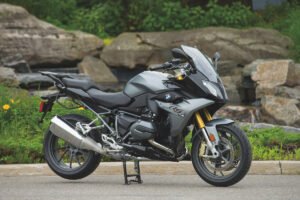 Despite spending most of my riding over the past few years aboard a GS, and the previous day on an XR, it only took moments to become comfortable with the slightly more aggressive seating position of the RS. The lower center of gravity made the RS light and confidence-inspiring, and feeling as though I’d been riding it for years, I switched from Rain to Road mode just a few miles down the road.
Despite spending most of my riding over the past few years aboard a GS, and the previous day on an XR, it only took moments to become comfortable with the slightly more aggressive seating position of the RS. The lower center of gravity made the RS light and confidence-inspiring, and feeling as though I’d been riding it for years, I switched from Rain to Road mode just a few miles down the road.
Though the Rain mode is a useful tool in a rider’s kit with its ability to soften throttle response and adjust ABS and DTC when desirable on wet or slick roads, in dry conditions the Road mode brings the bike to life with a livelier throttle response. Sadly, the Dynamic riding mode wasn’t available, but based on my own experience on my new XR, the added adrenalin rush of performance that selection provides will turn the RS into a two-cylinder rocket ship.
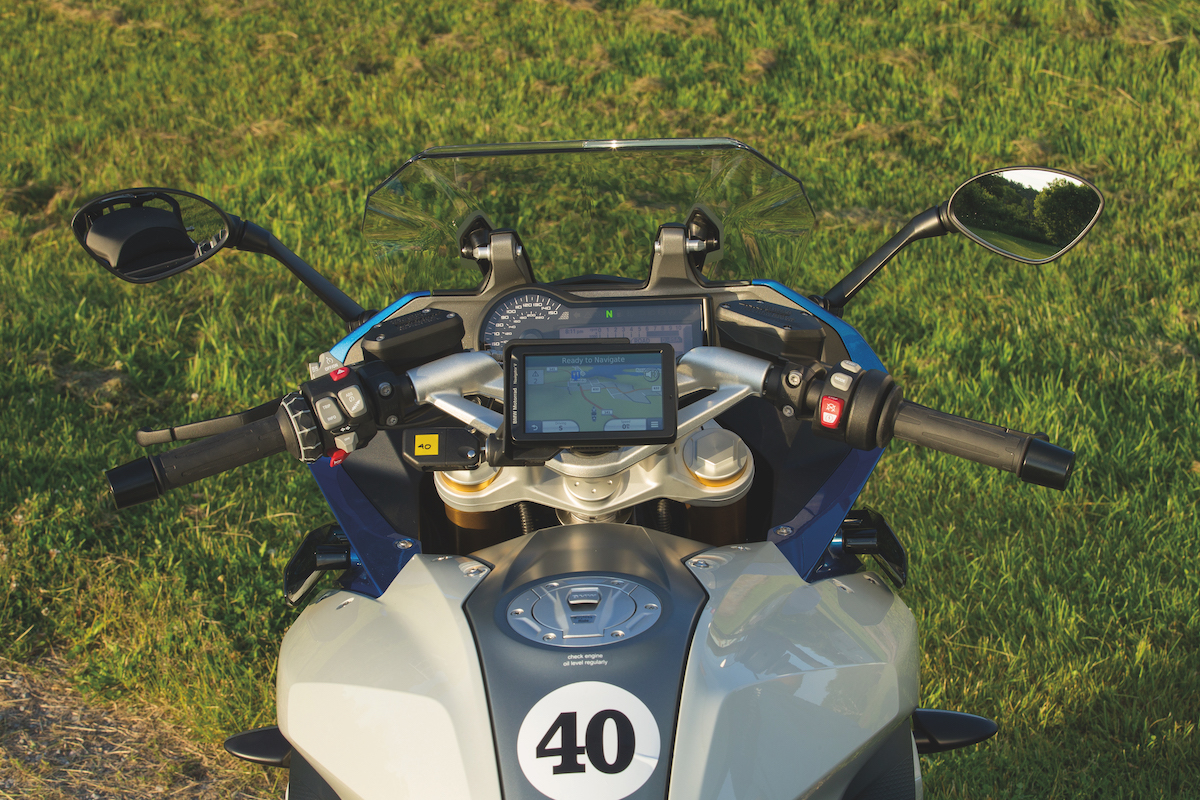 I found the instrumentation of the new RS the most complete and visually interesting display of data I’ve ever encountered on a motorcycle. With an analog speedometer on the left and digital display on the right, the ability to change how and how much information is presented is a thing of beauty. While the standard TFT display provides basic information including total mileage, trip 1 and 2 mileage, fuel range, ambient and engine temperature, mpg, average speed, date, oil level and tire pressure, the appearance of additional information including engine speed, mode, gear, suspension setting, fuel level and mph can be selected to suit the rider’s style.
I found the instrumentation of the new RS the most complete and visually interesting display of data I’ve ever encountered on a motorcycle. With an analog speedometer on the left and digital display on the right, the ability to change how and how much information is presented is a thing of beauty. While the standard TFT display provides basic information including total mileage, trip 1 and 2 mileage, fuel range, ambient and engine temperature, mpg, average speed, date, oil level and tire pressure, the appearance of additional information including engine speed, mode, gear, suspension setting, fuel level and mph can be selected to suit the rider’s style.
With the addition of the Navigator V, even more information is accessible, including a trip recorder, average fuel consumption, current fuel consumption, electrical system voltage, ride timer, service date and distance to next service.
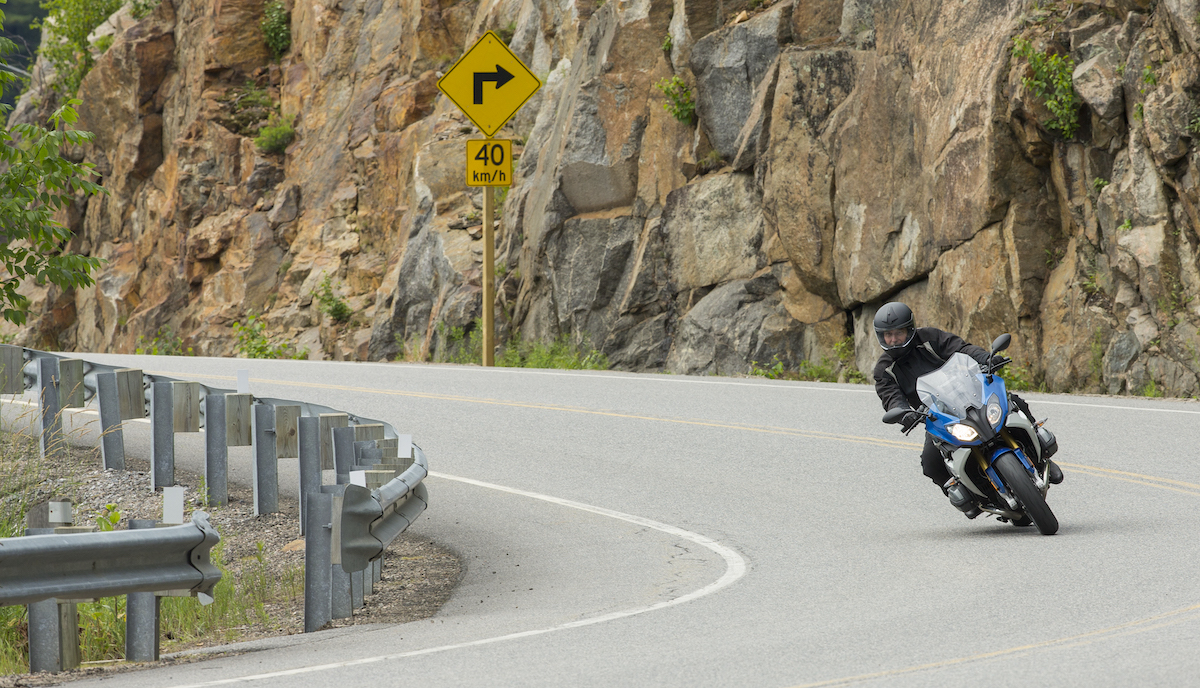 We had been warned during our pre-ride briefing that wildlife were active in the area and to remain always vigilant. While we did heed that advice, our ride was spirited with straights attacked and corners challenged. Exiting one particular corner we found a pair of deer lazily grazing the roadside, and taillights immediately came to life, allowing a test of not only braking ability, but that of ABS as well. Both performed flawlessly. Maintaining a keen eye, the only other wildlife we saw were turtle crossing signs and pastured cows.
We had been warned during our pre-ride briefing that wildlife were active in the area and to remain always vigilant. While we did heed that advice, our ride was spirited with straights attacked and corners challenged. Exiting one particular corner we found a pair of deer lazily grazing the roadside, and taillights immediately came to life, allowing a test of not only braking ability, but that of ABS as well. Both performed flawlessly. Maintaining a keen eye, the only other wildlife we saw were turtle crossing signs and pastured cows.
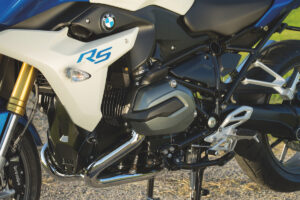 Canadian winters are tough on roads, and cold patch filled potholes were everywhere. In the worst sections, the Dynamic ESA set for a single rider absorbed the ride disturbances wonderfully, as the suspension’s damping was electronically adjusted in milliseconds. Experimenting with the two rider/luggage settings increased preload, with the single rider with luggage option working best for me. With more than five inches of front and rear suspension travel, the D-ESA always seemed to deliver a Goldilocks “just right” performance, firm when you need it and soft and plush when you don’t.
Canadian winters are tough on roads, and cold patch filled potholes were everywhere. In the worst sections, the Dynamic ESA set for a single rider absorbed the ride disturbances wonderfully, as the suspension’s damping was electronically adjusted in milliseconds. Experimenting with the two rider/luggage settings increased preload, with the single rider with luggage option working best for me. With more than five inches of front and rear suspension travel, the D-ESA always seemed to deliver a Goldilocks “just right” performance, firm when you need it and soft and plush when you don’t.
Like all boxer motors, the latest water-cooled version offers riders everything they’ve come to expect: stump-pulling torque over the entire rev range and a top end that’ll get a rider driving awards just as quickly as those aboard RRs. On the curving, two-lane roads, second and third gears were all that were needed, with higher gears only used on highways. I found Gear Shift Assist to be a usable option once I was able to get over my apprehension of not using a clutch. Though I didn’t find it as smooth or as easy to use as that on the XR, I believe it was due to my technique and not a mechanical issue, and as the day progressed I found it easier to shift more smoothly.
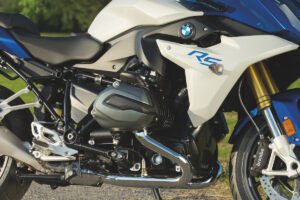 I predict the new RS will be a popular bike for BMW, perhaps even pushing the K 1300 S to its long-speculated extinction. With its all-day comfort, ride modes offering multiple personalities, superb suspension and iconic boxer motor, it hits all of the bases needed to be a success.
I predict the new RS will be a popular bike for BMW, perhaps even pushing the K 1300 S to its long-speculated extinction. With its all-day comfort, ride modes offering multiple personalities, superb suspension and iconic boxer motor, it hits all of the bases needed to be a success.
Never before has BMW offered as many unique models, and with each introduction, gaps between the bikes grow smaller. The 2015 BMW R 1200 RS bridges the gap between the pure Touring class dominated by the K 1600 GT/GTL and the R 1200 RT and the pulse-pounding experience of the Sport class, dominated by the S 1000 RR and K 1300 S.
On paper, the RS appears to be a compromise, and it is. In reality, it’s a bike offering a riding experience that blends the most desirable qualities of two classes into a single machine, restoring the RS as the undisputed King of the Hill in the Sport Touring category.
